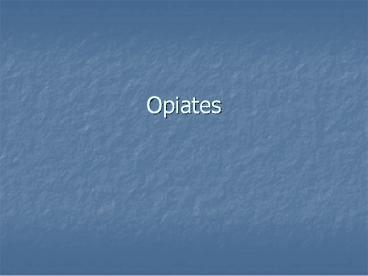Opiates - PowerPoint PPT Presentation
Title: Opiates
1
Opiates
2
Narcotics
- A drug that in therapeutic doses diminishes
sensibility, relieves pain, and produces sleep,
but in large doses causes stupor, coma or
convulsions any drug with properties similar to
morphine, identified as a narcotic drug by
federal law. - Goulds Medical dictionary
3
Source
- Opium poppy
- Papaver somniferum L
- Papaver Greek for poppy
- Somniferum Latin to dream or sleep
- Grows in India, Turkey, China, Mexico, SW Asia,
Afghanistan
4
Harvest
- Petals fall from the opium seed pod
- Approximately two weeks later unripe pods are
incised - Opium oozes out and dries in about 24 hours
- Then collected by hand
5
Yields
- Four kilos of opium per acre
- 80 mgs per plant
- 10 kilos of opium yield about 1 kilo of morphine
and morphine to heroin is a 1 to 1 conversion
6
Opium derivatives
- Opium
- Morphine
- Codeine
- Thebaine
7
Semi Synthetic Derivatives
- Heroin diacetylmorphine
- Eythylmorphine Dionine
- Dihydrocodeine Paracodin
- Hydromorpone Dilaudid
- Dihydrocodeinone Kycodan
- Oxycodone - Percodan
8
Synthetics
- Meperidine Demorol
- Methadone Methadon, Dolophine
9
- Earliest recorded use of opiates, circa 1500 BC
in the Ebers papyrus - Pharmacology book (Biruni 1000 AD) describing
opiate dependence - Early 16th century, Paracelsus created laudanum,
a mixture of wine and opium
10
- Dr. Thomas Sydenham (The English Hippocrates)
modified laudanum mixture, John Bell Hood - Morphine was isolated by Frederich Serturner in
1806 - Codeine (poppy head) was isolated in 1832
- English developed trade with China in the 19th
century through the East India Company
11
- English developed trade with China in the 19th
century through the East India Company - China had the problem of increasing opium
addiction and banned the importation of opium - This lead to the Opium War in 1840 to 1842 in
which England took control of Hong Kong
12
- 1853 the hypodermic needle was invented
- U. S. Civil War lead to the Soldiers Disease
- Heroin was transformed in 1874, thought to be 3X
more powerful than morphine
13
- Influx of Chinese laborers caused an increase in
opium smoking - 1890 Heroin was marketed by the Germans, may be
derived from the German heroisch meaning heroic,
dynamic or powerful
14
- Opiate abuse developed in the mid-19th century
- Harrison Act in 1914 (drugs secured by a
physician) - WWII heroin use increased in the lower classes
15
- 1960s saw an increase in the use of heroin as
well as other drugs - Vietnam war created the opportunity for increased
use of heroin among U.S. military personnel - In the 1970s black tar from Mexico became
available
16
- Current use includes upper middle class use
with purity of heroin increasing (40 to 60 )
17
Effects of Opium Derivatives
- Primarily an analgesic
- Constricted pupils, DRE
- Depressed respiration
- Constipation
- Nausea
- Drowsiness
- Euphoria
18
- Apathy
- Decreased sexual drive
- Tolerance
- Physical dependency
19
Dosage form and use (heroin)
- White powder
- Brown powder
- Black tar smoked
- Snorted
- Injected
- Skin popping
- Smoked
20
Chemical Characteristics
- Raw opium contains 10 morphine and small amounts
of codeine - Heroin is produced by the addition of 2 acetyl
molecules thus producing diacetylmorphine - Fentanyl (pain reliever) resulted in improved
anesthesia
21
- Narcotic antagonists (Naloxone) can reverse
overdoses
22
Mechanism of Action
- Leu-enkephalin and metenkephhalin act like
morphine - Endorphins found in brain tissue
- Midbrain (pain reception site) interaction
- Endorphins are released by the pituitary and
perhaps act in the spinal column but have an
unsubstantiated effect on the brain
23
Dependence Potential
- Tolerance develops with narcotic drugs
- Psychological dependence
- Behavior reinforcement of needle usage
24
Withdrawal
- Peaks in 24 to 36 hours
- Lasts 3 to 5 days
- Tearing of the eyes
- Runny nose
- Sweating
- Dilated pupils
25
- Loss of appetite
- Gooseflesh Cold Turkey
- Restlessness
- Irritability
- Tremor, convulsions
- Insomnia
26
- Depression
- Nausea and vomiting
- Cramps and diarrhea
- Muscle spasms Kicking the habit
27
Toxicity Potential
- Acute toxicity effects,
- Respiration
- Decreased mental ability
- Nausea/vomiting
28
Chronic Toxicity
- Sores at injection sites
- HIV/AIDS
- Hepatitis
- No long-term change in tissues or organs
29
Treatment
- Narcotic antagonists
- Methadone
- LAAM (L-alpha-acetyl-methadol)
- Buprenorphine
- Heroin/morphine maintenance
- Rapid opioid detoxification
- Delancy Street
30
Questions?































